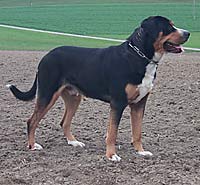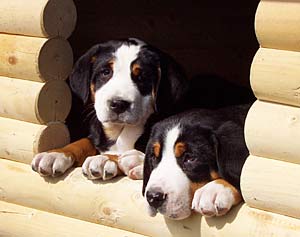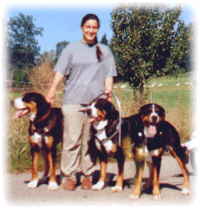 |
Greater Swiss Mountain Dogs
 |
| |
Bitch |
Dog |
| Shoulder height |
60-68 cm |
65-72 cm |
| Weight |
55-65 kg |
55-65 kg |
| Characterisctics |
Robust, muscular, easy
to handle, short coat |
| Character |
Confident, vigilant, affectionate,
a willing worker |
|
The Greater Swiss Mountain Dog is
the largest of the four Swiss Mountain breeds and is characterised
by a muscular and robust build.
He is confident, placid and even-tempered, but he is a good watchdog
and instinctively protects his “family“. In former times
the dogs were farm dogs and used as carting
dogs by peddlars and by farmers on their way to market and as herding
dogs by butchers. Still today the dogs enjoy this type of activity.
The Greater Swiss Sennenhund or Mountain Dog (GSS) needs a lot of
room, close contact to the owners and consequential but gentle training.
The dogs enjoy being on the farm or in a garden and do not tend
to stray. The breed is easy to handle and not over-demanding. The
dogs are good with children and demonstrate patience. They are natural
and incorruptible watchdogs and will be respected as such. |
 |
In a Word: A strong dog for the farm and
the home, who will give his family protection and security.
The dog’s strong bones, broad chest and muscular legs may
tend to make him look a little clumsy at first glance. However,
he can react like lightening and turn quickly. Bitches are between
60 and 68 centimetres high and dogs 65 to 72. The average weight
of an adult dog is between 65 and 72 kilograms. The dogs are not
only physically, but also mentally alert and willing to learn. They
like to be occupied and enjoy long walks and carting. |
 |
Despite the dog’s size, caring for a Swissy is relatively
uncomplicated. The short coat attracts little dirt. Dogs should
be brushed from time to time to remove dead hairs and it is a good
idea to clean the dog’s ears regularly as it is with all dogs.
The history of the breed can be traced back to the fourth century.
In Switzerland the dogs were often used for pulling carts, driving
and herding and guarding farms. They were also kept by butchers.
In former times health, robustness and performance were of greater
importance than appearance. In the nineteenth century the breed
went through a difficult period and almost became extinct. Through
consequent breeding at the beginning of the twentieth century the
breed was rescued and today is well-known and appreciated far beyond
the borders of Switzerland. |
|

